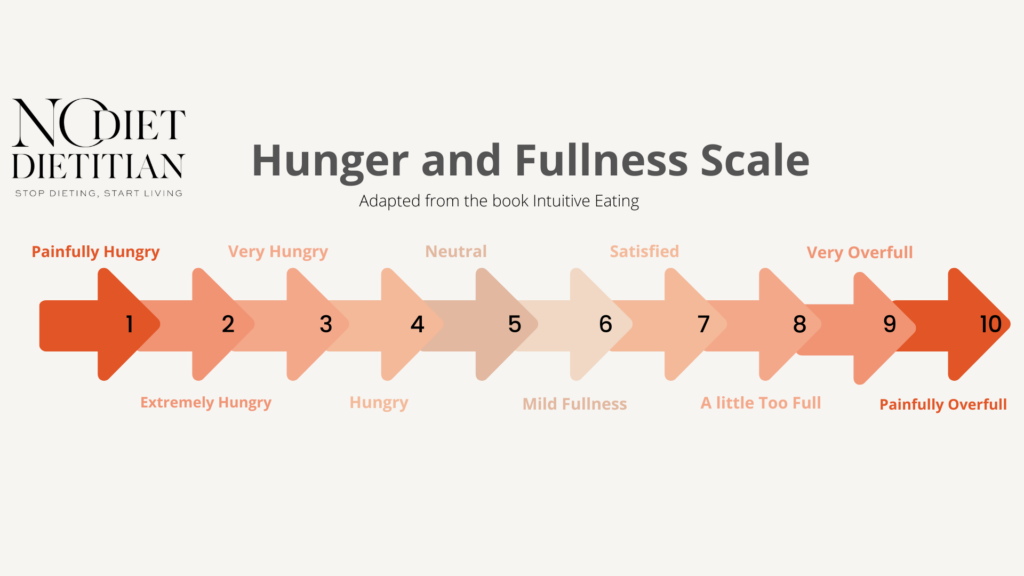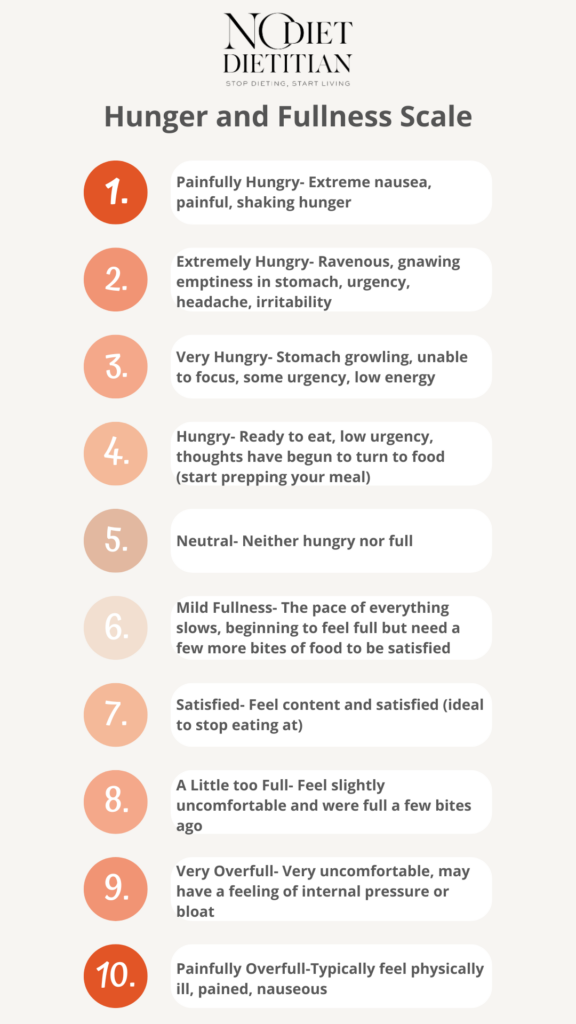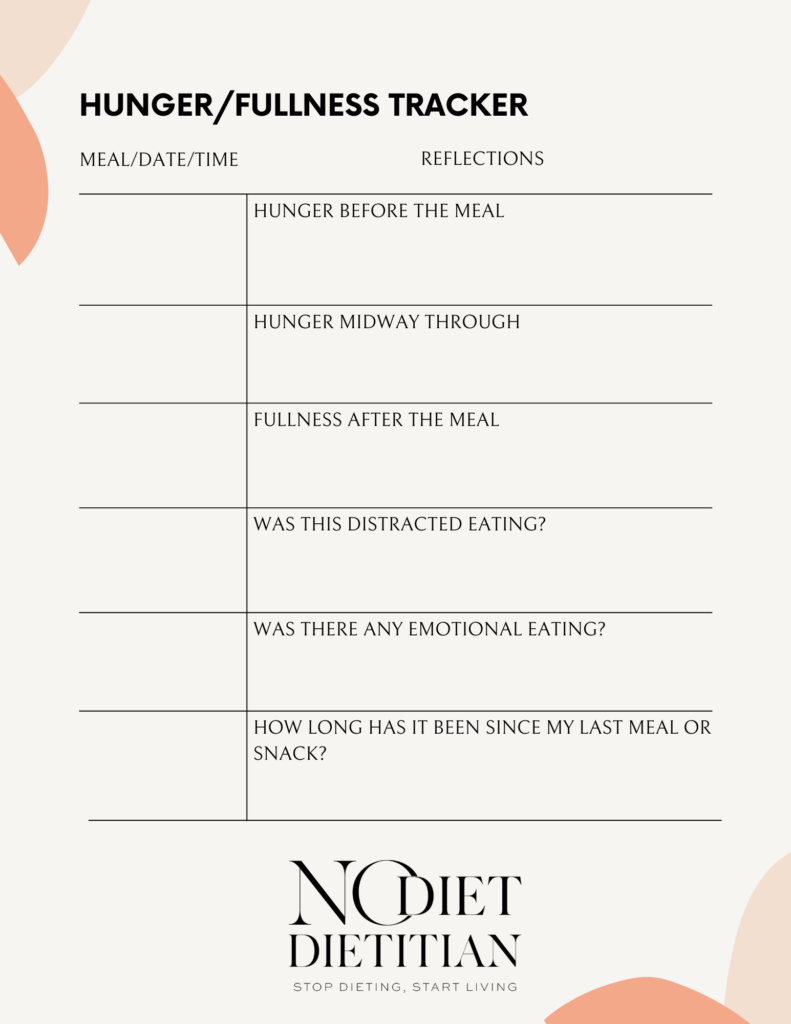No one wants to be hungry we would love to teach you how to navigate hunger and fullness because it can feel super scary to not know how to navigate hunger!
Hunger Satiety Scale
How often have you found yourself starting a meal ravenous because a meeting has run late? The next thing you know you have eaten more than you realize and are now overly full.
Have you ever found yourself not feeling hungry until way past lunchtime and then feel really full from only a few bites. Diet culture has told us to celebrate this feeling, when in reality it may mean our cues are not being heard. This can lead to low intake and a decreased (slowed) metabolism.
Understanding Hunger
Hunger may seem like a basic biological instinct but as a society we tend to fear hunger, we are scared of overeating and with a culture that it is more normal to be dieting than eating hunger has become challenging to navigate. Learning to navigate our hunger and our fullness is one of the most important skills I work on with my clients. This may sound like a simple task, but I find that it is often a skill that has been lost through the years.
Using the Hunger and Fullness Scale
I like to use a hunger/fullness scale to help my clients have a framework for how to deal with hunger and fullness. Below is the hunger/fullness scale, adapted from the book Intuitive Eating by Evelyn Tribole and Elyse Resch.

What is a hunger scale of 1?
We really want to avoid being a 1 on hunger or “painful hunger”. Surprisingly, often when people get to this point, they are past the point of physical hunger, are often nauseated or even lightheaded. This is where we start seeing the secondary and more severe side of hunger called hypoglycemia. If you ever find yourself at a 1, it is a good idea to grab something sweet like 8 oz of juice, a fruit or a candy immediately because this can progress to fainting and we want to keep you safe. Ideally when we cue into our hunger we don’t get to a 1.
Number 2 aka “Hangry”
Number 2, often called Hangry, includes irritability. This is often where you may find yourself feeling very easily frustrated, or as some of my clients say “I just can’t deal.” At this point, our fuse is short and it’s really hard to enjoy a meal when we are this hungry. Biologically our body just wants glucose (aka carbohydrates) and it gets in a state of fight or flight. This is when our stress hormone, Epinephrine, will help us produce more glucose from our liver (known as gluconeogenesis) to make sure our brain has enough glucose to function. Often, if we eat when we are extremely hungry, we end up overshooting the mark rather than stopping to eat at a 7. We overshoot because our body wants to take advantage of getting the energy in and we eat past the point of fullness. Getting to know our hunger can help stop the binge/restriction cycle that we see with so many people, especially when they have gone through many diets in the past.
Subtle hunger cues look different for everyone
In number 3, some people will find their stomach growling where others may find this inability to focus. This can look like re-reading the same paragraph multiple times or working on solving a problem that you know how to solve but just can’t seem to at this moment. It is super rewarding when we stop waiting to get to a 3 on the scale or start recognizing lack of focus as hunger because most of our clients see a huge increase in productivity and make fewer little mistakes!
When should I prepare meals or snacks?
Then number 4 is where we begin, what I call, our polite hunger. We have just started to think about food. This is where we will begin preparing our meal or snack so that we don’t end up overly hungry. Hunger is not a bad thing, it is our cue that our body needs fuel. It can be scary when we do not know how to deal with our hunger or if we are scared to eat food. Working with my clients, I help to reduce any stress or fear with food in a really personalized and individual way.
Once we reach a 6, it usually means we need just a few more bites of food to feel comfortably full. This might be the point in the meal where there seems to be more time in between bites or if we are eating with others the conversation seems to pick up as the pace of eating has slowed. Next is our comfortable fullness. At a 7 we are typically happy, content, and satisfied (hint: this is the goal!).
What does overfullness look like?
The last category of overfull starts at an 8 and goes to a 10. Reaching an 8 happens to everyone from time to time. At an 8, we probably were okay a few bites ago and have begun to feel just a bit too full. An example of this is when you are at a restaurant and you had a delicious meal but you want to try dessert and its so good you eat past the point of being comfortably full. Another example is when you are distracted and your kids need a lot of attention. You’re multitasking and eating and don’t notice the more subtle signals of satiety.
Being very overful at a number 9 includes bloating/ pressure on the stomach, this is not in reference to an external visual bloat but instead a feeling inside of being over extended.
Lastly, we have 10 which can include quite a bit of nausea, pain, and even a feeling that we may get sick. This will be as distracting as severe hunger. You’ll need to lie down and your body will need some time to work on digesting your food. Most people struggling with emotional eating experience being overfull and it is very common.

What is the ideal range of hunger/fullness?
One important thing to note is that while our ideal is a 4-7 for meals and snacks, life happens. Sometimes unexpected things occur and we start at 3, or maybe the food was just really yummy and we ended past the point of fullness (8). For this to happen occasionally is not a problem, but for every meal to be starting at a 3 or ending at an 8 indicates there is some work to be done.
Recommendations from a RD on how to use the hunger/fullness scale
Using this scale takes a bit of practice but my clients have found it invaluable! If you are new to checking in with your body, I recommend starting slow with one meal a day. Before you eat, practice sitting back and relaxing. Take a few deep breaths, close your eyes, and then try to find where you are on the scale. When you are about halfway through your meal it is helpful to check in again and ask, “does this still taste good, how hungry am I, and how much more do I think I need?” Once you finish your meal you will check in one last time for fullness.
How can learning about my hunger/fullness help me?
One of the amazing things about learning from your body is that with time you will learn which meals/food fill you up more than others. I have learned that a smoothie doesn’t fill me up as much as a yogurt bowl with fruit (even if I put the exact same things in my smoothie as in the bowl). Or you can learn that some nutrients feel better for your stomach, maybe there was more protein or a higher fat content in a particular meal. Start to notice how long the meal keeps you full for. Maybe you find that you tend to have distracted eating and this has prevented you from feeling your hunger or fullness.
How do I get started?
This is practice that takes time and that is okay. All that matters is that we start being curious about our body and its response. Remember, hunger is a tool that our body uses to help us fuel and feel our best, just as fullness is a cue that we have met our body’s needs! The best news of all is learning this is possible for us all. So why wait, below is a handout you can use to start and to record your practice!

Written by our Dietitian and Certified Intuitive Eating Counselor, Genevieve Traversa MS, RD, CIEC


+ show Comments
- Hide Comments
add a comment